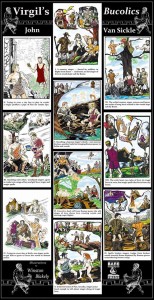Picturing Virgil’s Pastorals in Graphic Novel Style
¶ 1
Leave a comment on paragraph 1 0
 Picturing Virgil’s Pastorals in Graphic Novel Style
Picturing Virgil’s Pastorals in Graphic Novel Style
¶ 2
Leave a comment on paragraph 2 0
The Bucolics scored their first success in the realm of spectacle:
Virgil issued them, his ancient biography reports, with such success that also on the stage by reciters they were frequently performed: bucolica eo successu edidit ut in scena quoque per cantores crebro pronuntiarentur.
The report does call for commentary. What might bucolica mean to an audience at Rome, say in the upper class neighborhood clustered on a hill called Palatine? Would bucolica resonate with lore and legends of the Palatine itself, with its cult of Arcadian Pan, which was a mythology that had experiential roots in the ownership and raising cattle, sheep, and goats—a source of material wealth that was basic to the Mediterranean economy.
Issued in any case to what select audience in what way that could win success? How did these peculiar pieces captivate? Indeed win translation to the stage? Did they match theatrical traditions and expectations, incorporating both Greek satyr drama and rowdy Roman mime? Might bucolica be recognized too as a peculiar variant of Greek epos?
In any event, translated not merely to the stage, but frequently (the adverb suggests repeated performances, even a production run), how does that inference square with the rule in republican Rome that stages were temporary, erected by specific magistrates for specific festivals then taken down, lest political advantage accrue to any one? What stage then could provide the venue for a long run and who would commandeer it? Whose interests would such productions serve?
Keeping in mind success on the Palatine and descent to production down on the Campus Martius, the present inquiry considers how bucolic drama translates into visual representation: a special case of ancient and varied interaction between text and picture, as evoked for example by Penny Small, The Parallel Worlds of Classical Art and Text (Small 2003); or by Sara Brunori, showing how Greek painters blended scenes from the epic cycle, “II racconto mitico fra tradizione iconografica e tradizione poetica,” with illustrations from vase painting to argue that painters shaped their own variants of crucial moments from epos, often combining in one frame scenes separate in narrative time and space; she describes, e.g., the judgment of Paris, the duel of Achilles with Penthesilea, and one vase showing Menelaus reclaiming Helen while Neoptolemus kills both Priam and his grandson, Astyanax (Van Sickle 2011); or by Gregory Nagy when he emphasizes relationships between the spectaclar in epos, tragedy, and monumental architecture (Van Sickle 2012).
From the common experience of the pastoral economy, painters abstracted vignettes and idylls, what David Wright styles “a general repertory of bucolic scenes” to which he relates the illustrations for the great Roman Virgil, from which seven of ten survive (Wright 2001). The first surviving folio contains the first eclogue and the picture “illustrates the opening lines exactly,” in Wright’s view; he allows that “the only departure from the text is the shape of the leaves above Tityrus” (p. 14), although in fact this Tityrus looks if anything more youthful than Meliboeus. It appears that the illustrator, who registers Tityrus’ cattle and Meliboeus goats from the initial challenge and riposte, neither read on nor recalled the stagily introduced white beard that marks Tityrus as old and thus serves as a metapoetic marker of the age of bucolic tradition.
¶ 3
Leave a comment on paragraph 3 0
<note:Cantare Habinek>
References Cited
¶ 4
Leave a comment on paragraph 4 0
Small, Jocelyn Penny
2003 The Parallel Worlds of Classical Art and Text. Cambridge: Cambridge University Press.
Van Sickle, John
2011 Review of Ettore Cingano (Ed.), Tra Panellenismo e Tradizioni Locali: Generi Poetici e Storiografia. Bryn Mawr Classical Review Bryn Mawr Classical Review 2011.11.62.
2012 Review of Nagy, Homer the Classic. Bryn Mawr Classical Review http://bmcr.brynmawr.edu/2012/2012–03–46.html.
Wright, David Herndon
2001 The Roman Virgil and the Origins of Medieval Book Design. Toronto: University of Toronto Press.
References Cited
¶ 5 Leave a comment on paragraph 5 0 http://www.thefullwiki.org/Vergilius_Romanus: small vignettes of five eclogue pictures


Comments
Comments are closed
0 Comments on the whole Post
0 Comments on paragraph 1
0 Comments on paragraph 2
0 Comments on paragraph 3
0 Comments on paragraph 4
0 Comments on paragraph 5